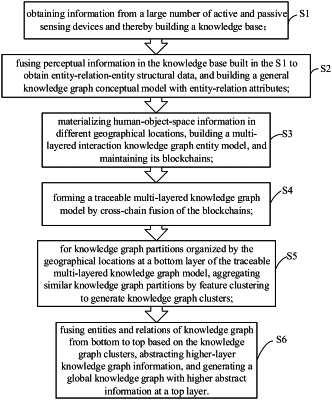| CPC G06N 5/022 (2013.01) | 4 Claims |

|
1. A construction method of human-object-space interaction model based on knowledge graph, comprising the following steps:
S1: obtaining information from active sensing devices and passive sensing devices and thereby building a knowledge base;
S2: fusing perceptual information in the knowledge base built in Si to form entity-relationship-entity structured data, and building a general knowledge graph conceptual model with entity-relation attributes;
S3: materializing human-object-space information in different geographical locations, building a multi-layered interaction knowledge graph entity model, and maintaining blockchains of the multi-layered interaction knowledge graph entity model;
wherein S3 specifically comprises:
S301: partitioning the multi-layered interaction knowledge graph entity model for the different geographical locations to obtain human-object-space interaction knowledge graph partitions, the knowledge graph partitions maintaining respective private blockchains; and for a same one of the different geographical locations, heterogeneous data from different sources being uploaded to the private blockchain, and after all nodes on the private blockchain are audited and reach a consensus, retaining effective heterogeneous data configured to enter a next stage of the cross-chain fusion and thereby obtain the traceable multi-layered knowledge graph model; and
S302: during collecting the heterogeneous data, using a real-time clustering method to cache different real-time stream data and verify the real-time stream data;
S4: obtaining a traceable multi-layered knowledge graph model by cross-chain fusion of the blockchains;
wherein S4 specifically comprises:
S401: the private blockchains maintained by the respective knowledge graph partitions, based on a multi-layered multi-chain architecture of side chains or relay chains, fusing the knowledge graph partitions by a cross-chain data fusion method;
S402: the private chain maintained by each of the knowledge graph partitions being used as a side chain to work in parallel with a main blockchain, and nodes of the main blockchain connecting to the side chain or being connected by the side chain; and
S403: the side chain independently from the main blockchain collecting heterogeneous data of multiple source devices in a corresponding one of the different geographical locations, or performing data fusion of heterogeneous data together with the main blockchain;
S5: for knowledge graph partitions organized by the geographical locations at a bottom layer of the traceable multi-layered knowledge graph model, aggregating the knowledge graph partitions based on similarity by feature clustering to generate knowledge graph clusters; and
wherein the aggregating the knowledge graph partitions based on similarity in S5 specifically comprises:
S501: extracting main features of each of the knowledge graph partitions by feature engineering; and
S502: classifying a series of knowledge graph partitions through a machine learning feature clustering method;
S6: fusing entities and relations of knowledge graph from bottom to top based on the knowledge graph clusters, abstracting higher-layer knowledge graph information, and generating a global knowledge graph with higher abstract information at a top layer;
wherein S6 specifically comprises:
S601: for the global knowledge graph being queryable anywhere at its bottom layer, performing fusion on the knowledge graph clusters generated in S5, and generating a knowledge graph at the bottom layer and fusing knowledge graph partitions in the same knowledge graph cluster of the knowledge graph at the bottom layer to obtain a higher-layer abstract knowledge graph; forming a bottom-up pyramidal information abstract model including the knowledge graph located at the bottom layer and the higher-layer abstract knowledge graph located at an upper layer of the bottom layer as the global knowledge graph, and storing the bottom-up pyramidal information abstract model by using cross-chain fusion of blockchains, wherein a knowledge graph stored at a topmost layer of the bottom-up pyramidal information abstract model is a root node for querying, and thereby gradually searching down from the knowledge graph stored at the topmost layer of the bottom-up pyramidal information abstract model to the knowledge graph stored at the bottom layer of the bottom-up pyramidal information abstract model to obtain more specific information when querying.
|